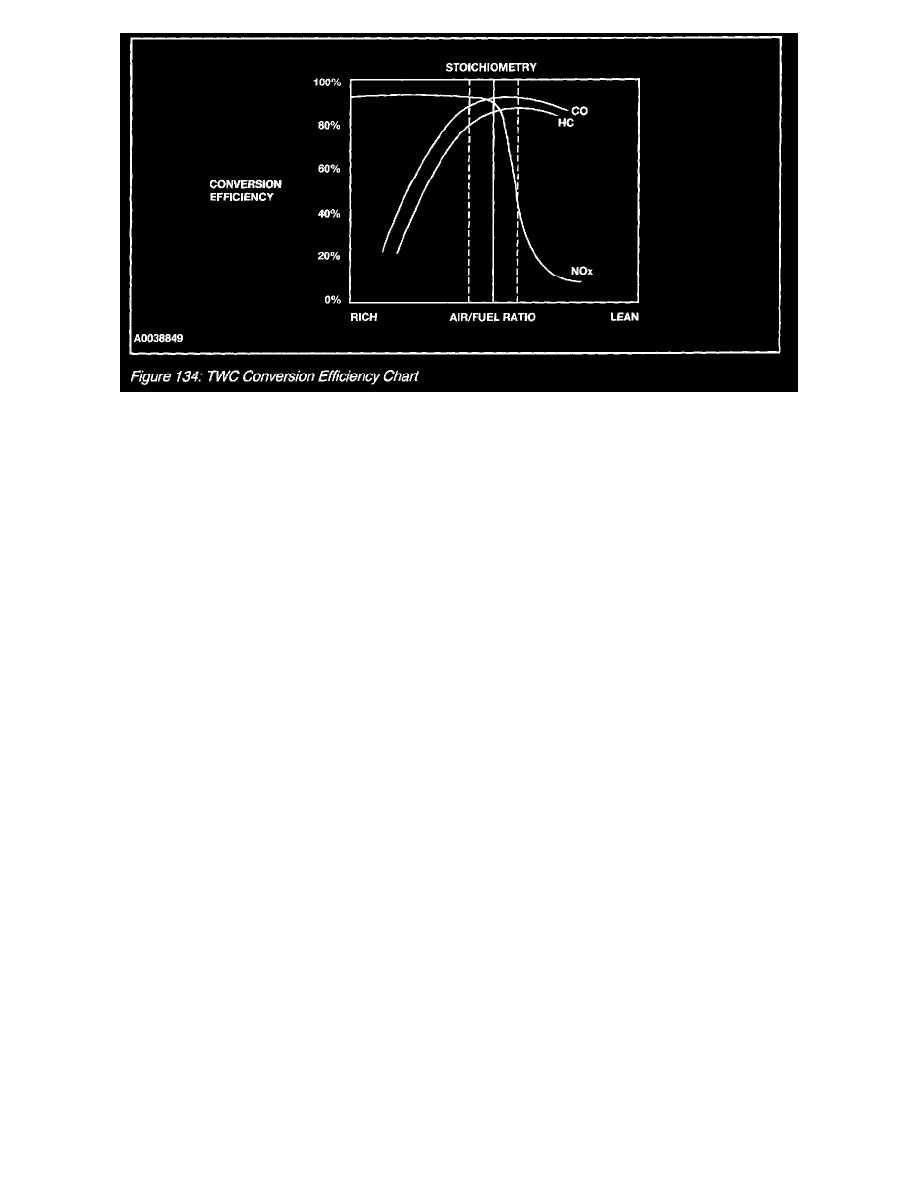F 150 2WD Pickup V8-4.6L (2002)

TWC Conversion Efficiency Chart
A TWC requires a stoichiometric fuel ratio, 14.7 pounds of air to 1 pound of fuel (14.7:1), for high conversion efficiency. In order to achieve these
high efficiencies, the air/fuel ratio must be tightly controlled with a narrow window of stoichiometry. Devations outside of this window will greatly
decrease the conversion efficiency (Figure 134). For example a rich mixture will decrease the HC and CO conversion efficiency while a lean mixture
will decreases the NOx conversion efficiency.
Exhaust System
The purpose of the exhaust system is to convey engine emissions from the exhaust manifold to the atmosphere. Engine exhaust emissions are directed
from the engine exhaust manifold to the catalytic converter through the front exhaust pipe. An HO2S is mounted on the front exhaust pipe before the
catalyst. The catalytic converter reduces the concentration of carbon monoxide (CO), unburned hydrocarbons (HCs) and oxides of nitrogen (NOx) in
the exhaust emissions to an acceptable level. The reduced exhaust emissions are directed from the catalytic converter through another HO2S mounted
in the rear exhaust pipe and than on in the muffler. Lastly, the exhaust emissions are directed to the atmosphere through an exhaust tailpipe.
Hardware
The downstream HO2S may be located after the light off catalyst or underbody catalyst. The underbody catalyst may be in-line with the light off
catalyst, or the underbody catalyst may be common to two light off catalysts, forming a "Y" pipe configuration. For an exact configuration of the
catalyst and exhaust system, refer to Exhaust System.
Three Way Catalytic Converter
The three way catalytic (TWC) converter contains either platinum (Pt) and rhodium (Rh) or palladium (Pd) and rhodium (Rh). The TWC
converter catalyzes the oxidation reactions of unburned HCs and CO and the reduction reaction of NOx. The three-way conversion can be best
accomplished by always operating the engine air fuel/ratio at or close to stoichiometry.
Exhaust Manifold/Runners
The exhaust manifold runners collect exhaust gases from engine cylinders. The number of exhaust manifolds and exhaust manifold runners
depends on the engine configuration and number of cylinders.
Exhaust Pipes
Exhaust pipes are usually treated during manufacturing with an anti-corrosive coating agent to increase the life of the product. The pipes serve as
guides for the flow of exhaust gases from the engine exhaust manifold through the catalytic converter and the muffler.
Upstream Heated and Downstream Heated Oxygen Sensors
The HO2S provide the Powertrain Control Module (PCM) with voltage and frequency information related to the oxygen content of the exhaust
gas. (Refer to the PCM Inputs for a description of how the HO2S operates.)
In addition to providing the PCM with indications of how rich/lean the engine is operating, the upstream HO2S signal serves as an input to the
HO2S monitor. The downstream HO2S signal is an input to the Catalyst Efficiency monitor. (Refer to the OBD II Monitors for specific
information on these monitors.)
Muffler
Mufflers are usually treated during manufacturing with an anti-corrosive coating agent to increase the life of the product. The muffler reduces the
level of noise produced by the engine, and it also reduces the noise produced by exhaust gases as they travel from the catalytic converter to the
